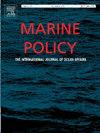气候变化中的航运燃料路径:2050年的前瞻性研究
IF 3.7
2区 社会学
Q2 ENVIRONMENTAL STUDIES
引用次数: 0
摘要
本研究考察了波罗的海航运业的燃料使用和环境影响。它侧重于评估环境法规的影响,并在监管硫氧化物和氮氧化物排放的同时提出脱碳方案。通过技术可用性、成熟度、燃料价格、能源结构和监管来评估作为高硫和碳密集型燃料(HFO)替代品的减排措施和替代燃料。在短期内,使用洗涤器的重油被认为是具有成本效益的,但预计替代燃料将在更严格的法规下取代它。液化天然气(LNG)的硫氧化物排放量为零,价格范围为每吨230-955欧元,由于甲烷泄漏问题限制了其对脱碳的贡献,因此只能被视为过渡燃料。从长远来看,甲醇、氢气和氨是实现无SOx排放和实现脱碳目标的潜在解决方案,其最佳份额分别为30% %、35% %和35% %。就绿色燃料而言,到2050年,氨的价格区间为350 - 995欧元/吨,氢为100-600欧元/吨,甲醇为300-700欧元/吨,甲醇的最低资本支出为200-400欧元/千瓦。为实现2050年净零排放的减排目标,扩大甲醇和推进氢、氨技术需要大量的行业和监管努力。本文章由计算机程序翻译,如有差异,请以英文原文为准。
Shipping fuel pathways in a changing climate: A prospective foresight study for 2050
This study examines fuel use and environmental impact of shipping industry on Baltic Sea. It focuses on assessing the effects of environmental regulations and proposing decarbonisation scenarios while regulating the SOx and NOx emissions. The abatement measures and alternative fuels as replacements for high-sulphur and carbon-intensive fuels (HFO) are evaluated through technology availability, maturity, fuel price, energy mix and regulation. In the short term, HFO with scrubbers is considered cost-effective, but alternate fuels are expected to replace it with tighter regulations. Liquefied natural gas (LNG), which has zero SOx emission and competitive price range of 230–955 euro per ton, can only be considered as transitional fuel due to methane slip issues limiting its contribution to decarbonisation. For the long term, methanol, hydrogen, and ammonia are potential solutions for achieving SOx free emissions and meeting decarbonisation targets with best possible share of 30 %, 35 % and 35 % respectively. In case of greener fuels, price range varies from 350 to 995 euro/t for ammonia, 100–600 euro/t for hydrogen, and 300–700 euro/t for methanol in 2050, with minimum capex value of 200–400 euro/kW for methanol. Scaling up methanol and advancing hydrogen and ammonia technologies require significant industry and regulatory efforts to achieve the 2050 emission reduction targets of net zero emissions.
求助全文
通过发布文献求助,成功后即可免费获取论文全文。
去求助
来源期刊

Marine Policy
Multiple-
CiteScore
7.60
自引率
13.20%
发文量
428
期刊介绍:
Marine Policy is the leading journal of ocean policy studies. It offers researchers, analysts and policy makers a unique combination of analyses in the principal social science disciplines relevant to the formulation of marine policy. Major articles are contributed by specialists in marine affairs, including marine economists and marine resource managers, political scientists, marine scientists, international lawyers, geographers and anthropologists. Drawing on their expertise and research, the journal covers: international, regional and national marine policies; institutional arrangements for the management and regulation of marine activities, including fisheries and shipping; conflict resolution; marine pollution and environment; conservation and use of marine resources. Regular features of Marine Policy include research reports, conference reports and reports on current developments to keep readers up-to-date with the latest developments and research in ocean affairs.
 求助内容:
求助内容: 应助结果提醒方式:
应助结果提醒方式:


